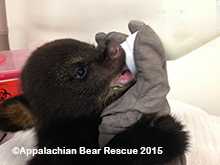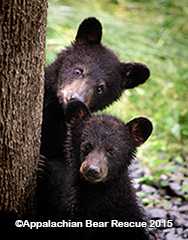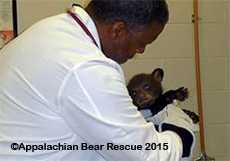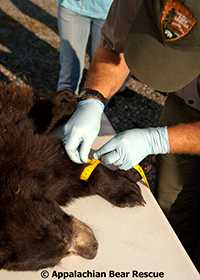Rescued Bears Get a Second Chance
It’s a sunny spring morning and three black bear cubs are lapping up milk replacer formula and rice cereal at the Appalachian Bear Rescue Center near the Great Smoky Mountains, also known as the Smokies. Weighing 3-5 pounds each, the cubs are living in the woods at the sanctuary until they grow strong enough to return to their natural habitat.
 Coy Blair, a curator at the center, bottle-feeds the tiny cubs and provides sliced grapes for them to eat. He tries to wean them as quickly as possible to keep the animals from being dependent on humans; having a healthy fear of humans helps bears survive in the wild after being released.
Coy Blair, a curator at the center, bottle-feeds the tiny cubs and provides sliced grapes for them to eat. He tries to wean them as quickly as possible to keep the animals from being dependent on humans; having a healthy fear of humans helps bears survive in the wild after being released.
Bears naturally fear and avoid people, which is a good instinct. When people feed bears or leave garbage within reach, bears begin to expect food from humans, developing unsafe habits, including charging at people; breaking into cars, buildings, or tents looking for food; and, occasionally, injuring or killing people.
The Appalachian Bear Rescue Center in Townsend, Tennessee, gives orphaned and injured cubs across the Southeast a second chance at life in the wild by educating humans about safely sharing the planet with bears. Blair reminds the public to respect these bears as wild animals, always keeping a safe distance from cubs, no matter how cute and cuddly they look.

Don’t try to make cubs into pets. They belong in the wild.
“I can’t get attached to them,” Blair explains after he feeds the trio of cubs. “My goal is to get these animals back to the wild. I don’t pick them up and hold them against me and get them used to human contact; that would be dangerous for them.”
Studies have shown bears that lose their fear of people by obtaining human food and garbage never live as long as bears that feed on natural foods and are shy and afraid of people. According to the National Park Service, many that lose their fear of people are hit by cars and become easy targets for poachers.
Two of the three cubs were found on a cliff near the Blue Ridge Parkway, apparently orphaned. Concerned citizens saw them and alerted a National Park Service dispatcher, who called Appalachian Bear Rescue to investigate. There was no sign of the mother bear. The sibling cubs had been alone for many hours. A park ranger loaded the animals into a carrier and Appalachian Bear Rescue officials took “Bonnie Blue” and “Ridgeway” to a safe haven in the Smokies, the cub nursery.
The third cub, “Marvin,” had meandered from the woods into civilization. When he appeared in someone’s yard in Tennessee, they called wildlife officers, who safely transported the dehydrated cub to Appalachian Bear Rescue. At first, Blair fed the cub with a syringe. When Marvin could lap food out of a dish, he graduated to an enclosure with rocks and trees and learned to eat and live like a bear in the wild; the staff provided food such as seasonal fruit, berries, nuts, acorns, shoots, and roots.
As a nonprofit organization, Appalachian Bear Rescue relies on its friends to donate food and other basic items.  For instance, schoolchildren collect acorns in the woods and boy and girl scout groups gather fruit at “you-pick” farms.
For instance, schoolchildren collect acorns in the woods and boy and girl scout groups gather fruit at “you-pick” farms.
The Appalachian Bear Rescue organization began as a grassroots effort in 1990 after a previous autumn had been hard on the black bear population of the Smokies; a nut and seed shortage had driven them out of the mountains to look for food. When they reached civilization, a number of hungry bears were killed, leaving behind orphaned cubs.
A group of dedicated volunteers formed a rescue center in Townsend to help the Tennessee Wildlife Resources Agency and Great Smoky Mountains National Park care for the orphaned cubs. In the 25 years since, hundreds of people and organizations, from the local supermarket to the University of Tennessee, College of Veterinary Medicine, have donated their time and money to save more than 200 bears.
Among the success stories, “Little Bear Bobby” was found in a roadside ditch filled with water one dreary March day. Passersby alerted wildlife officials, who thought perhaps Bobby had become separated  when his mother was moving her cubs. Whatever the cause of his abandonment, he weighed only 3 pounds when rescued and had to be bottle-fed on milk replacer formula until he was able to lap it up from a bowl, along with yogurt and applesauce. Cubs grow fast, and Bobby was soon able to eat other soft foods such as berries, grapes, and lettuce, followed by apples, pears, carrots, and nuts. He gobbled everything in sight.
when his mother was moving her cubs. Whatever the cause of his abandonment, he weighed only 3 pounds when rescued and had to be bottle-fed on milk replacer formula until he was able to lap it up from a bowl, along with yogurt and applesauce. Cubs grow fast, and Bobby was soon able to eat other soft foods such as berries, grapes, and lettuce, followed by apples, pears, carrots, and nuts. He gobbled everything in sight.
After a few months at Appalachian Bear Rescue, Bobby was moved from the nursery to a large, natural enclosure where he could play and explore in the trees, grass, ponds, and foliage. His exposure to humans ended, and staff members began throwing his food over a blind-covered fence so that Bobby couldn’t see the humans providing it.
By the time he was released in the wild that December, Bobby had grown to a healthy 144 pounds. Now back in his natural environment, he has a second chance at life to rely on his true bear instincts to survive and thrive.
Bear Safety Tips
Seeing a bear is a special treat when you visit its natural habitat, but remember that bears are wild animals and might be dangerous. Follow these safety tips:
- Keep your distance. Stay at least 50 yards away from a bear. Approaching a wild animal so closely that it changes its behavior means you are too close. Use binoculars or a camera with a zoom lens.
- Avoid surprising wildlife. Never try to sneak up on a bear to get a close look; the animal might react defensively. Make noise to let it know you are there. Talk, sing, yell, wear bear bells, blow a whistle, bang pots, do whatever it takes so that a bear hears you coming.
- Don’t feed bears. Wild animals should have a healthy fear of humans. Feeding bears makes them dependent on humans for survival and can cause them to become bold in search of human food and garbage. This can result in nuisance bears that end up being captured and relocated to another area or killed.
- When camping, never cook or eat in your tent. Your tent will smell of food and could attract bears. Don’t bring odorous non-food items like toothpaste, candy, and wrappers into your tent.
- Use aerial food storage cables to store your food and garbage out of reach of the bears when camping in the backcountry.
- Don’t litter. Throw chewing gum, watermelon rinds, banana peels, and other food scraps in a bear-proof trashcan and not on a hiking trail.
- Teach children to respect bears. Teach them to keep a safe distance and not to disturb wild animals when viewing them.
- Never get between a mother and her cubs.
- Don’t pick up bear cubs. Don’t take them to your house. First, the mother could be nearby; you could put yourself in harm’s way. The mother might abandon the cubs because she’s scared of you, but she will probably come back for them if you leave the area. Call a wildlife or police officer for help if you notice cubs that seem to be lost or abandoned.
- Don’t run from a bear. It might view you as prey, and it can run three times faster than you. In a sudden bear encounter, make loud noises, avoid abrupt movements, and back away slowly.
- Hike in groups. Closely control children and pets, and carry bear spray.
- Page last reviewed: September 30, 2015
- Page last updated: September 30, 2015
- Content source:


 ShareCompartir
ShareCompartir